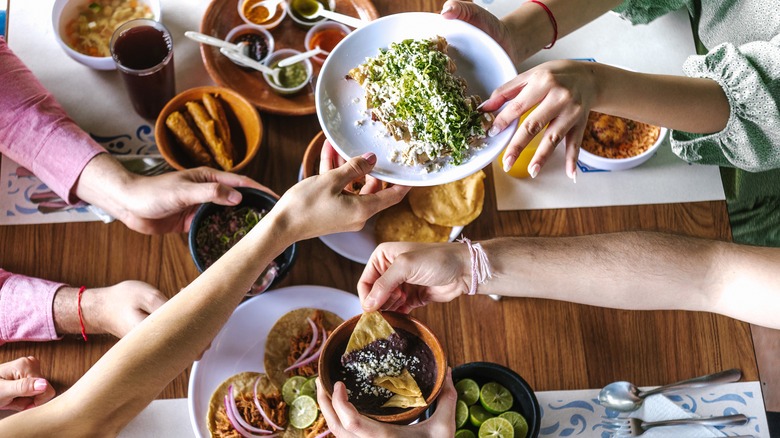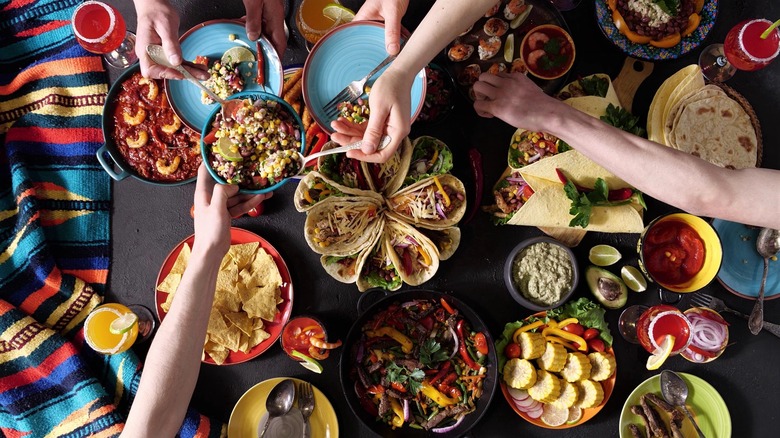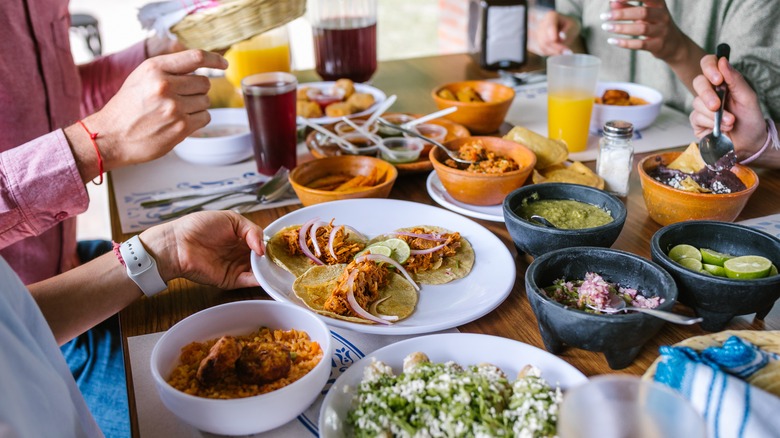Why It's Bad Etiquette To Pass Plates To Your Right In Mexico
The rules that govern table manners vary depending on the part of the world where they are practiced. Everything from how silverware is laid out on the table to when it's polite to begin eating can be different from country to country, and sure to baffle uninformed international travelers. One example has to do with the common etiquette for passing dinner dishes. In both American and Continental (European style) dining, plates are passed counterclockwise from the left to the right. In Mexico, however, passing to the right is actually considered bad etiquette — there the correct direction for passing is to the left. One uses their right hand to offer a dish to the person on their left, who then receives the plate with their left hand, and uses their right to plate the food. This makes it convenient for right-handed people to use their dominant hand to serve themselves.
This convenience is secondary to the real reason Mexican fine dining favors moving dishes clockwise. The origin of the tradition may stem from a historical bias against the left hand and left-handedness in general. Not unique to Mexico, the taboo exists in many cultures, all of which have varying degrees of restrictions involving what can and cannot be done with the left hand. These customs almost always revolve around eating — with a central belief that the left hand is considered unclean and unlucky — and therefore should not come into contact with food.
The sinister origin of left-hand intolerance
The association of the left hand with all things dirty relates to personal hygiene. In some countries and religions, the left hand is used for cleaning oneself after using the toilet as well as for washing up when bathing. Stigmas surrounding hand usage exist in Hindu, Islamic, African, and Latin American cultures, and trace back to pre-biblical times. The Bible itself mentions handedness quite a few times, with a leaning towards the right hand being the exalted side, as in the New Testament's various references to the right hand of God.
This deep-seated prejudice has an even darker side, with left-handed people throughout history being associated with wickedness and the Devil. For centuries, children were forced to use their right hand if they showed an inclination for their left, and during the Middle Ages, lefties in Britain were accused of witchcraft and some were burned at the stake. These superstitions are reflected in the language we use today — the English word sinister derives from the Latin sinistra, which as a noun means left hand, and as an adjective means something inauspicious or improper.
Given these negative connotations, we can see how superstitions regarding all things left crept into dining etiquette, and why across the globe, including in some Latin and South American countries, using the left hand to touch food at the table is considered bad luck. Like Mexico, passing plates around the table in Colombia is also done to the left.
Old superstitions have not been left behind
Despite only about 10% of the population being left-handed, the minority's effect on societal hand restrictions for eating is widespread. In Mexico, diners following acceptable protocol will wait for their host to announce "Buen provecho" (meaning to enjoy) before they begin eating. Hands should remain visible, not hidden under the table where they can be perceived as indicating dishonesty, and plates will move from right to left. In India, where the left hand is directly associated with certain bodily functions, touching food with it is considered highly offensive, and food must always be passed with the right. Unlike Mexico, in India, the left hand should be kept hidden from view while eating.
In certain Islamic beliefs, eating with the left hand is forbidden. This extends throughout the Middle East and into Africa — where hand and hand-related regulations are common in Egypt, Iran, Saudi Arabia, Morocco, and Kenya, to name a few. This is especially strict in Ethiopia where rules for eating with your hands govern how communal food is shared, and the left hand is used only in the bathroom. In Ghana, if you mistakenly use your left hand in public, you are expected to offer an apology. Thankfully, table manners in Mexico are less rigid, and as long as you remember to keep your hands where everyone can see them, and don't break the leftward flow of plates, everything will be all right.



